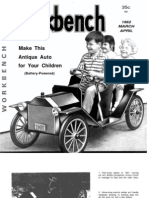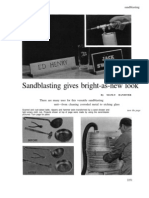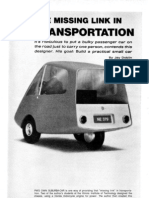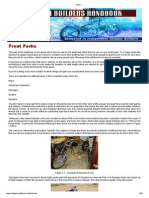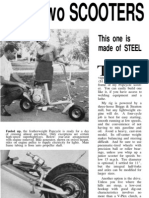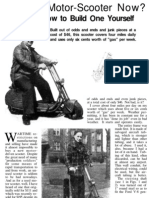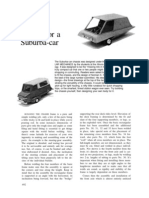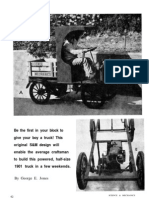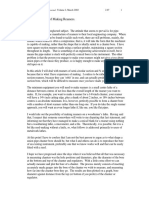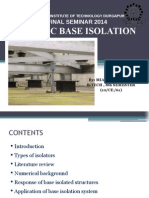100%(1)100% found this document useful (1 vote)
1K views2706 Building Speedster
2706 Building Speedster
Uploaded by
sjdarkman1930This summary provides an overview of the document in 3 sentences:
The document describes Ken Shebler's process of building a 1926 Model T Ford Speedster over 4 years, starting with researching period designs and collecting parts. It details the mechanical work done, including modifying an OHV cylinder head and using a Model A crankshaft. The first part focuses on the engine work, such as balancing the crankshaft and preparing the cylinder head.
Copyright:
Attribution Non-Commercial (BY-NC)
Available Formats
Download as PDF, TXT or read online from Scribd
2706 Building Speedster
2706 Building Speedster
Uploaded by
sjdarkman1930100%(1)100% found this document useful (1 vote)
1K views10 pagesThis summary provides an overview of the document in 3 sentences:
The document describes Ken Shebler's process of building a 1926 Model T Ford Speedster over 4 years, starting with researching period designs and collecting parts. It details the mechanical work done, including modifying an OHV cylinder head and using a Model A crankshaft. The first part focuses on the engine work, such as balancing the crankshaft and preparing the cylinder head.
Copyright
© Attribution Non-Commercial (BY-NC)
Available Formats
PDF, TXT or read online from Scribd
Share this document
Did you find this document useful?
Is this content inappropriate?
This summary provides an overview of the document in 3 sentences:
The document describes Ken Shebler's process of building a 1926 Model T Ford Speedster over 4 years, starting with researching period designs and collecting parts. It details the mechanical work done, including modifying an OHV cylinder head and using a Model A crankshaft. The first part focuses on the engine work, such as balancing the crankshaft and preparing the cylinder head.
Copyright:
Attribution Non-Commercial (BY-NC)
Available Formats
Download as PDF, TXT or read online from Scribd
Download as pdf or txt
100%(1)100% found this document useful (1 vote)
1K views10 pages2706 Building Speedster
2706 Building Speedster
Uploaded by
sjdarkman1930This summary provides an overview of the document in 3 sentences:
The document describes Ken Shebler's process of building a 1926 Model T Ford Speedster over 4 years, starting with researching period designs and collecting parts. It details the mechanical work done, including modifying an OHV cylinder head and using a Model A crankshaft. The first part focuses on the engine work, such as balancing the crankshaft and preparing the cylinder head.
Copyright:
Attribution Non-Commercial (BY-NC)
Available Formats
Download as PDF, TXT or read online from Scribd
Download as pdf or txt
You are on page 1of 10
THE MAKlNG OF A 1926
MODEL T FORD SPEEDSTER
By Ken Shebler
Vermont South
Australia
From a sketch to reality.
Dreams can come true with a little perseverance.
Ed. Note. So you think you want to build a
Speedster' Ken Shebler is well known down under
for his engineering and mechanical prowess. For-
tunately for Speedster fans, Ken made a detailed
record of his latest profect and has offered to share
it with us. 1his is the first part of a two part series.
1he final installment will appear in the January-
February issue. Given that Ken speaks Australian
and I speak American, I asked 1ed Aschman to
help translate or offer American equivalents to
some of Ken s procedures. Our apologies to Ken for
any error in our translations. If you are mechani-
cally inclined, we think you will enfoy Ken s ap-
proach to the many facets of his profect.
AIter having restored several Model T Eord
vehicles, I waited to take up an additional chal-
lenge-1 wanted to step up into a modern sports
car, and had my eyes on an English MG TC or TE.
One oI my club Iriends has an MG TC and a couple
oI years ago I tried the 'cockpit Ior size. Those
who know me realize that this is a prerequisite Ior
an acceptable marriage oI man and car. (Ed. Note.
Ken is 6 foot 4 inches, plus.) Alas, the shoehorn Iit
proved uncomIortable and aIter evaluating the
situation Iollowing a Iive minute exit, I decided an
MG-TC/TE was not Ior me.
What to do? Well I like Model T Eords and I
like restoring them, which in my case entails re-
building new bodies, both woodwork and metal
exterior. So I decided to start up a new challenge oI
building a Model T Eord Speedster. That was in
1987. Thus commenced what I call my 'T6 pro-
ject.
The Iirst thing I did aIter this decision was to
talk, see, read and ask. I looked up all my old
Jintage Ford and Model 1 1imes magazines to get
ideas and I purchased any and all books and arti-
cles relating to the use oI Model T Eords as racing
cars. I was pleasantly surprised to Iind that a lot oI
28
inIormation was available Irom the old days. Such
books as Dykes Motor Manual (the 13th edition, in
particular), Model 1 in Speed and Sport, Model 1
Speed Secrets, Chevrolet Brothers Erontenac
Catalog No. 81 and other articles were a gold mine
oI inIormation. Many accessory companies sup
plied the 1920 s market with products to convert
the Model T Irom the Iamily car to a smart and
Iast speedster or dirt track racer. However, such
accessories are seldom available today, and one
has to be content with modern alternatives, as
reproductions or adaptions oI the original.
I also spoke with many Iriends in the various
Model T Eord clubs in which I am a member. Here
was the wealth oI inIormation on 'how-to and
'what with regarding the best way to proceed
with my project.
Erom all this inIormation, I slowly Iormed a
solid picture oI how I would proceed and what
components I would use, or at least try and obtain
Ior use.
The body shape and Iorm was a matter oI
personal taste Ior me. I wanted to have a body
style to match the era but at the same time one oI
some comIort Ior me.
The basic design Ieatures that I wanted to
emulate had to include:
1. Overhead valve conversion oI the era
2. Lowered suspension -Iront and rear
3. Extraction type exhaust
4. Wire wheels
5. Sporting-type body style
I succeeded in achieving all the above with my
1926 Model T Eord Speedster. It took me a total oI
Iour years to prepare, get design ideas, collect,
restore, build and register Ior normal road use.
And I am very happy with the result. It is now
ready Ior our next rally.
There are many club members who are cur-
rently building or who would like to build a Model
T Eord Speedster. Having just completed such a
project successIully I would like to share my expe-
rience with other members as to how I went about
the construction oI this project. Here is the de-
tailed construction story oI my 1926 Eronty T Eord
Speedster.
THE MECHANlCALS
L BASIC ENGINE
I started with a 1926 motor with rear hogs-
head support mounting, 4-dip crankcase pan,
transmission cover to suit, a Erontenac OHV unit
Ior the Model T, and a Model A crankshaIt.
Erontenac Cylinder Head
I obtained an original Eronty 8-valve head
complete with aluminum cover, valve rocker gear,
pushrods and valve springs. The Erontenac head
was stamped as a 'Model T |on the upper head
Ilange| and I modiIied it to make it a 'Erontenac
Model R by planing oII 0.125 to increase the
compression. I also had to counterbore the pre-ma-
chined combustion chambers to 3.900 diameter
by 1/8 deep to allow Ior the stroke oI the Egge
Machine Co high compression pistons |I used a
bore size oI 3-7/8 diameter, same as the Model Al.
The compression ratio is now about 9:1 and pumps
175 pounds per square inch (PSI).
The rocker shaIt and rocker arms were re-
stored; the shaIt reground and the rocker arms
Iitted with new bronze bushings, machined to pro-
vide 0.001 clearance. The rocker arm Iaces were
reground to give a smooth movement over the
valve end and the pushrod end. When I reassem-
bled the valve rocker assembly, I placed a 1/16
thick shim under each oI the Iour pedestal sup-
ports-the idea being to allow a small space Ior
any oil to drain down the pushrod apertures and
ultimately return to the sump.
The valves I used were stainless steel |spec.
21.4.N| 1-7/8 diameter head with 0.3415 diame-
ter stem, overall length 5-17/32 , with grooves ma-
chined into the stem to accommodate the original
taper collets (retainers). You can also use a
Chevrolet 427 exhaust valve made by Manley or
others, and modiIy to suit.
The length oI the valve stem was important in
the sense that as each activating surIace oI the
valve rocker arm is a sliding surIace, the lateral
distance oI slide could be minimized |thereby re-
ducing Iriction, noise and power loss| by ensuring
that 'valve close position or height corresponds to
the height oI pedestal support plus halI the valve
opening.
New valve guides, using the originals as a
sample, were machined Irom phosphor bronze
with 0.001 clearance to the valve stem on all
valves except Ior cylinders 2 and 3 exhaust valves
|the inner valves| which had 0.0025 clearance.
Eor lubrication oI the valve rocker assembly I
used a 1 thick Ielt pad and attached this to the
upper mechanism. This pad is regularly saturated
in engine oil. To prevent oil seeping down the valve
stems I installed rubber grommet wipers.
I used a modern 14 mm spark plug |Champion
S9YC| using a permanently installed adaptor into
the original 7/8 SAE standard spark plug thread.
(Don t conIuse this thread - 18 TPI - with a 7/8
SAE {UNE} |Note: United National Eine or UNE is
Australian equivalent to SAE| which had 14 TPI.)
29
Cr ankshaI t
I decided to use the more robust Eord Model A
crankshaIt and counterbalance it.
The 'A crank is about 5/16" longer between
the inner Iaces oI No. 1 and No. 3 main bearings
journals than the Model T crank, and oI course has
larger diameter main bearing |and big end| jour-
nals. It was important to ensure a modiIied 'A
crank had the same dimension between the outer
Iace oI No. 1 main bearing journal and the inner
|and outer| Iace oI the Ilange oI No. 3 main bearing
journal.
To achieve this requirement it was necessary
in this calculation to use the lateral centerline
between No. 2 and No. 3 cylinder bores oI the "T"
block to match the lateral centerline oI No. 2 main
bearing oI the 'A crank. Thus, the 'A crank was
modiIied and trimmed back in lengths both Iront
and rear. BeIore commencing any work on the
crank, I made sure it was not cracked. This can be
done by modern crack testing means (magnaIlux-
ing). However, the enduring way is to hang the 'A
crank vertically by a wire and rap it with a metal
object e.g. a hammer. II it hums Ior a time at both
ends, it s okay. II there is a dullness oI tune any-
where, discard it.
I was able to paper press the outline oI a Eord
Model C crankshaIt counterbalance, and I sub-
sequently used this proIile on the 'A crankshaIt. I
used a mild steel proIile 5/8 thick plate to make
the counterbalances. Using a cutting torch, I cut
out the plate, machined, cut to shape, bolted to the
'A crank with 2-1/2" x 3/8 UNE high tensile Un-
brako setscrews, held in by Locktite and pinned by
a heavy centerpop on the counterweight periphery.
The counterweights were then MIG welded on the
side Iaces to the crankshaIt circular web.
AIter all the modiIications were completed the
crankshaIt was ground on all journals and rear
Ilange thrust Iaces, then dynamically balanced.
Engine Block
I used a good 1926 engine block as a base Ior
my engine. There were several machining steps
necessary- n e w main bearing blocks, bearing
bolts, line boring, metalling (babbitting), Iinish
boring, cylinder reboring, and minor metal re-
moval near the camshaIt bosses.
The block was sandblasted and checked Ior
any cracks, particularly in the bores (cylinders)
and emanating Irom the exhaust valve seats. The
block was then surIace ground on the upper Iace to
ensure a Ilat surIace and also surIace ground to a
witness level |witness level, in this case means
that the deck or top oI the block was surIaced to be
exactly parallel to the bottom Ilange1 on the lower
machined Ilange. All tapped holes were then
cleaned out with square bottom taps, and the head
bolt holes i n-
s pect ed. Any
wor n or dam-
a ge d t hr e a ds
were r epai r ed
with helecoils.
I made a
new set oI main
bearing blocks
and bolts. These
were bolted to
t he
block,
engine
mat ch
marked and line
bored to 1-3/4
d i a me t e r . At
t hi s t i me, ap-
p r o x i ma t e l y
9/64 was tre-
panned oII the
inner Iaces oI
the main bear-
ing No. 1 and
No. 3 bosses and
1/16 taken oII
Model A crankshaft with counterweights, together with main bearing caps.
A standard Model T crankshaft can be seen at the top of the photo.
30
each side oI the
ma i n be a r i ng
to clear the swing oI the counterweight oI the
crankshaIt.
Because I expected considerable engi ne
torque, I decided to use Ilexible mounts Ior attach-
ing the crankcase arms to the chassis. I used only
one Iixture per side-in the upper Ilange oI the
chassis using a radius rod ball cap spring and a
1-1/2 X 3/8 UNE hex head bolt, castellated nut
and split (cotter) pin. This allowed considerable
spring loaded movement without stress to the
crankcase arms.
As well as modiIying the crankcase sump/en-
gine mounting, I added a crankcase support, the
so-called 'bra, which was also used in the old days
to reinIorce the crankcase arms and prevent them
Irom breaking.
The oil pan had to be modified to clear the larger
Model A crankshaft and connecting rods. Model A crankshaft and connecting rods.
31
No. 2 boss, all to match the width oI the new main
bearing caps.
AIter tinning the bearing block and boss sur-
Iaces, new Hoyt 11D whitemetal (rabbit) was
poured. I did not use any shims. AIter accurate
setup in the line borer, using the camshaIt hole as
a reIerence Ior location, the main bearings were
line bored to the correct size Ior the crankshaIt
with 0.0015 clearance and Iaced on No. 3 main
bearing to provide 0.004 lateral clearance on the
Ilange thrust Iace. Oil holes were drilled in the
bearings and oil grooves were machined into the
whitemetal (babbit) bearing surIace oI the block
halI.
When the crankshaIt was trial Iitted to the
block, it was necessary to chip or grind a small
amount oI metal Irom the Iront inner boss oI
the camshaIt journal bore and Irom the inner
web oI the block near the rear camshaIt jour-
nal bore. This was done so that the counter-
weights oI the crankshaIt would be able to
swing easily with adequate clearance in case
oI lateral movement caused by thrust Iorces
Irom the helical gears oI the crank-camshaIt
drive.
The cylinders were then bored and honed
to 3-7/8 diameter to suit the Egge pistons,
with a clearance oI 0.002 . The original valve
chambers and engine intake and exhaust
ports were dressed up with 'Erontenac alumi-
num covers Irom Bill Rader oI Los Angeles.
Crankcase Sump |Pan|
I obtained a 4-dip crankcase sump. Using
the lower door gasket as a pattern I Ilame cut
a 1/2 thick mild steel spacer and drilled this
Ior the bolt hole pattern with 5/16 diameter
holes. The original horseshoes were used and
Iixed in their location by two 1/4 BSW by 1/2
long CSK HD |counter-sunk head1 screws
each. This was so they would not move when
assembly was being carried out.
It was necessary to bell out, in Iour spots
per side, a small area oI the sides oI the crank-
case sump to clear the swing oI the 'A con-
necting rods and big end (rod cap) nuts. The
location had to be accurate and aIter Iinally
heating up the required areas to a red heat
and using a ballpeen hammer the objective
was achieved. The side widths oI the Ilange
was checked and brought back to correct di-
mension to Iit the engine Ilange mounting.
It was also necessary to beat down the
lower rear Ilange behind No. 4 big end on the
crankcase sump. Plus, it was necessary to
grind the 1/2" thick spacer in this area in order
El ywheel
I used a standard Ilywheel. The magnets were
removed and the Ilywheel cleaned and checked Ior
cracks. I then lightened it by machining an annu-
lar ring 13-W outside diameter by 10-3/4 inside
diameter by 5/8 deep with generous radii, all on
the Iront Iace, i.e., opposite Iace to that on which
the ring gear mounts.
I retained the 16 aluminum magnet stools and
used M6 by 40 mm (very close to 1/4 x 24 TPI
thread, as used by Eord) hex head setscrews to
mount these and the ring gear to the Ilywheel.
These metric threads have almost the same pitch
as the original brass screws and bind only on the
last turn which oI course only tends to hold them
tighter. They were then peened on the exposed end
threads Ior security.
I then installed new triple gear shaIts to be
certain any possible extra power would at least be
equally taken on new components.
The Ilywheel was then statically and dynami-
cally balanced. The rebuilt Ilywheel assembly
weighed 28 pounds, a reduction oI 27 pounds Irom
the original rotating mass oI 55 pounds.
Transmi ssion
Here I used a standard pre-1926-27 transmis-
sion with the narrow Iace brake drum. The clutch
spline surIaces were okay and I rebushed all bear-
ing surIaces. The 1926-27 transmission would
have been better only because these had 'shoes on
the clutch splines which didn t wear so much and
were replaceable. The brake surIace was not used.
All these components were balanced beIore Iinal
assembly.-
I installed a 'Jack Rabbit clutch which
really is only a GM Turbo 400 or Allison disc
set with the internal splines Iiled to match the
Model T requirements. I used the heavy duty
type with grooved Iaces. The eight clutch discs
were soaked in heavy oil beIore assembly-
heavy oil because it was to be some time be-
tween assembly and Iiring up the motor and I
didn t want oil drained 'bare Iaces which
could have been the case with light oil, or no
oil!
Eor the transmission bands |only low and
reverse were used1 I used the new woven
Kevlar linings obtained Irom The Rocky
Mountain Machine Company oI Colorado
Springs, Colorado. The bands are mounted on
'quick change bands.
The universal ball cap (4th main) was
modiIied to Iit a ball bearing |SKE 6010-2RS|.
The modiIications entailed installing a bush-
ing between the transmission shaIt and the
bearing, a 1/4 thick Ilange spacer, and a
sleeve spacer to locate the bearing and stop
the inner bearing bushing Irom working Ior-
ward on the transmission shaIt and leaving
the bearing and outer housing "high and dry.
BeIore I assembled the transmission, I
checked the tension oI the clutch spring-it
was 110 lbs at 2 |minimum 90 lbs required|.
Once assembled, I adjusted the 'clutch Iinger
gap to 7/8 rather than the 13/16 recom-
mended. This resulted in a non-slipping
clutch, very capable oI handling the greater
power oI the modiIied engine. The transmis-
sion cover was only modiIied to preserve oil,
i.e., stop the oil leaks on the shaIts. Eor low
speed and reverse shaIts I used the 'O ring
trick inside the bracket Ilanges. The clutch
32
shaIt bore was machined out to 3/4 diameter and
bushed back to 5/8 diameter-but cutting the
bushing to allow a groove 0.093 wide in which an
'O ring was placed. Eor saIe measure I also used
the duplex internal spring, washer and 'O ring
trick on the internal Iace. This has proved very
satisIactory.
The standard Model T camshaIt was reIur-
bished by Wade CamshaIts oI Melbourne. The
camshaIt was built up and reground to a No. 102
grind with timing oI 20/60 - 60/20 and a 0.263 liIt
at the lobe. That means-inlet opens 20 degrees
beIore top dead center (TDC), closes 60 degrees
aIter bottom dead center (BDC); outlet opens 60
degrees beIore BDC, closes 20 degrees aIter TDC.
With a tappet clearance oI 0.011 and a 1.5:1 ratio
on the rocker arms, the valve opening is now
0.373 .
I used a good steel 3-spoke camshaIt gear to
match with a new crankshaIt gear. I was told, iI
possible, to use a 4-spoke gear. I was also warned
not to use a Iibre gear.
Pistons/Connecting rods
I purchased a set oI special pistons Irom Egge
Machine Company oI CaliIornia. The pistons were
3-7/8 diameter, high compression, domed head
with raised gudgeon (wrist pin hole) to suit the
Model A connecting rod.
The Egge piston tended to pump oil without
some minor modiIications. These modiIications in-
cluded cutting a relieI groove below the oil ring
together with drilling oil drain holes on each side
oI the gudgeon hole outside the gudgeon retaining
circlip (clip). I also had to relieve the dome oI the
piston back to 3.780 diameter so it would be able
to enter |with clearance| the combustion chamber
oI the Eronty head.
Because the centerline distances are slightly
diIIerent between the 'T block and the 'A crank,
it was necessary to take oII about 1/16 Irom one oI
the inner bosses oI No. 1 and No. 4 pistons so that
the gudgeon little end boss clears.
The pistons were match balanced to within 0.2
gram oI each other. Assembling the gudgeon, I
decided to use a Seeger internal circlip rather than
the wire (wrist pin clip) circlip supplied by Egge.
The connecting rods used are standard Model
A, oI the H-type web. These were remetalled (re-
babbitted) with Hoyt 11D whitemetal, machined to
suit the crankshaIt with 0.0015 clearance |here I
used a set oI Model A laminated rod shims| and oil
ways were drilled and machined. The connecting
rods were then matched and balanced within 0.5
gram total weight and big end/gudgeon |end Ior
end| weights. I used 7/16 UNE Nyloc nuts (lock
nuts using nylon plastic ends-used on aircraIt
and race cars) Ior big end nuts rather than the
standard Model A with split (cotter) pins.
Oil System
I decided that the splash Ieed system would be
retained but upgraded. I used a 1/2 diameter cop-
per internal oil line with a large Iunnel mounted in
the now Iree space between the engine block and
the Ilywheel. Not using the standard Eord mag-
neto meant that I dispensed with the magneto
plate. This 1/2 line had to be 'bruised in spots to
clear the crankshaIt counterweights.
The standard Model A connecting rod dippers
now have a larger sump in which to take their oil
supply.
I Iitted an accessory outside oil line as well.
Being 3/8 diameter copper tube, it takes its oil
supply Irom the Iormer magneto post connection
on the transmission cover. I drilled/tapped a 1/4
BSP (British Standard Pipe-like ISP) hole in the
lower part oI the block just above the position oI
the crankshaIt gear.
I also Iitted an accessory transmission oil
screen, which I have Iound very eIIective.
2. CARBURETOR
AND FUEL SYSTEM
I acquired a NOS Stromberg MBI carburetor,
which I used without any modiIication. I swivelled
the air intake towards the rear and Iitted it with
an air cleaner. The carburetor Iitted, with a short
adaption piece, mounts directly onto the inlet con-
nection oI the Eronty head.
I used a 12-volt Autopulse electric Iuel pump
and adjusted the line pressure to about 1-2 PSI. A
bowl Iilter was installed between the main cock
under the Iuel tank and the Iuel pump. The Iuel
line to the carburetor was 5/16 diameter copper. I
made a 1/4 diameter copper return line back to
the bottom oI the Iuel tank in which I included a
1/4 needle valve which was cracked open Ior ad-
justment oI return Iuel Ilow. This line was neces-
sary to relieve the pump pressure when the
carburetor Iloat was in the closed |or near closed|
position, and thus prevent Ilooding.
The Iuel tank was made oI 2mm aluminum
and glass beaded externally. It had dimensions oI
14 diameter by 25 long and holds 14 Imperial
gallons |approximately 15 US gallons1 oI petrol. I
mounted it on two small supporting saddles with
1 wide metal straps. All the surIaces were sepa-
rated by rubber protector bands.
33
side sealed.
At the pin-
ion end oI the
driveshaIt, im-
mediately Iol-
lowing t he
machined sec-
tion, I cut a 1-
1/16 - 12 UNE
bastard thread
and matchi ng
nut . Because
the Iorged shaIt
varies Irom 1-
1/32 diameter
to 1-1/16 di-
ameter it was
di IIi cul t t o
stipulate exact
thread outside
diameter. The
nut had an out-
side di amet er
oI 1-11/16 by
3/4 wide with
two 5/16 BSW
hol es t a pped
radially at 90
Photo shows the left-hand side of the engine with Stromberg MBI carburetor,
air cleaner, and water pump.
3. GEARBOX, DRIVESHAFT,
degrees to each other.
DIFFERENTIAL AND REAR AXLE
To some purists I committed a sin! I adapted a
GM Holden gearbox into the driveshaIt about 12
back Irom the universal joint. I would have pre-
Ierred a Ruckstell but this 'setup" has proved
practical and immeasurably cheaper to accom-
plish.
I then made a special sleeve which Iitted in-
side the driveshaIt bearing housing the cup oI the
taper roller bearing Iitted into the driveshaIt bear-
ing housing and the ball bearing Iitted into the
special sleeve, which in turn Iitted into the
driveshaIt bearing housing.
I won t go into too much detail oI what I did.
The gearbox was a GM Holden EJ to HR Series
with aItermarket Iloor gearshiIt mechanism which
I modiIied. I got all this in good condition at vari-
ous swap meets. I also needed a matching clutch
plate and universal shaIt, oI which only the Iemale
splines were oI interest to me.
Once assembled, including the Holden gear-
box, the length oI this drive train was exactly that
oI an original Model T driveshaIt.
A Model T driveshaIt and housing were cut to
the appropriate lengths, Ilanges matching the
gearbox welded and machined to the driveshaIt
housing and the Iemale splines shrunk on and
welded to the driveshaIt. The weldings oI the
driveshaIt were important and so a special weld-
ing technique was used as well as a low hydrogen
alloy electrode.
The diIIerential is a standard Model T but uses
thrust washers made Irom bronze. |I used a 3:l
crown wheel (ring gear) and pinion ratio.| The
axle s outer roller bearings were replaced by adap-
tor Ilanges with sealed ball bearings 6006/2RS
|55mm diameter x 30mm diameter x 13 mm| - two
per side. As well, I made inner shaIt seals using an
Apache oil seal P 2151 |1-1/2 diameter x 1-1/16
diameter x 5/16 | in a Ilanged housing, to stop the
oil Irom being thrown onto the brake shoes and
leaking over the wheel. The two grease cups were
retained Ior aesthetic purposes but the screw lids
were drilled with 1/8 diameter holes as breathers.
What I did to the rear end oI the driveshaIt
could be termed 'modern T so I will describe this
in detail. I used modem bearings-Timken taper
roller bearing 15578/X523 |2-3/8 x1 x 5/8 | and a
ball bearing RLS 8 - RS |2-1/4 x1 x5/8 | with one
4. FRONT AXLE
I used a standard Model T 1926-27 Iront axle.
This axle has a bow in it compared with earlier
axles, and I think it was important to use this as it
34
gives a little more clearance under the extended
crank handle because oI the lowering system de-
scribed later.
Also, the 1926-27 stub axles are raised by 1/2
on the vertical member, thus providing a partial
lowering oI the chassis. The vertical member has a
center which I drilled out and tapped 1/4 UNE
and Iitted a small greaser (grease Iitting) to grease
the king pin bushings. The wheels have to be
turned Ior this purpose. I used 1926-27 wire wheel
hubs in their standard Iorm.
6. SUSPENSION - FRONT/ REAR
Basically I lowered the chassis 5-1/2 Iront and
rear, and the Iollowing describes how this was
achieved:
Er ont
I decided to make the Iront axle lower by
bringing the axle out in Iront oI the chassis. I made
up the 5-W lowering brackets Irom mild steel
sections with an oIIset to allow Ior a caster oI 3/4
|measuring the angle oI the king pin| and byusing
the standard Iront radius rod. The axle was bolted
into Iorward Iacing lugs on the brackets using 4 x
9/16" UNE high tensile bolts and castellated nuts.
As the axle perch mounting holes are 11/16
diameter I used some rolled steel bushings leIt
over Irom tie rod bolt kits as bushing spacers. Eor
the new Iront spring perch I used the 1909-25 rear
spring perch and cut them in width to 1-1/2 . The
Iront spring and spring mounting were standard
Model T mounted in their original position. The
lowering kit actually places the Iront axle 2-3/4
Iorward oI its original position.
I welded brackets to the lowering kit to mount
telescopic shock absorbers.
The shocks used were 1975 Eord Cortina dou-
ble acting Armstrong 74BA-18077AIA. The chas-
sis brackets Ior the shocks were made Irom 2
angle and side plate, the angle being bolted to the
chassis and the side plates supporting the shock.
Because the shocks were mounted at an angle oI
45 degrees Irom the vertical, reaction Iorces would
tend to twist the chassis, which when seen at this
point is very weak in torsion, so I used a 1 x5/8
bar across the chassis behind the radiator but in
Iront oI the Ian, bolting to the leIt- and right-hand
shock mounting side plate. This has made the
shock system very strong and eIIective.
The radius rod ball mounting was upgraded,
because this is where a lot oI rattles originate on a
rough road. I rewelded the radius rod ball and
ground it to Iit into a newly purchased brass ball-
cap. It didn t have to be perIect-just Iit and move
without binding. I then used the brass ball cap
upside down in the transmission sump mounting
aIter grinding it
to Iit. It is in-
v a r i a b l y t h e
case that these
mountings are
wo r n o u t t o
about 1-1/2' and
the new cap Iits
easily.
With an old
steel ball cap, a
3/4 BSP sock-
et, one radius
cap mount i ng
s pr i ng, s ome
pl umbi ng I i t -
tings and a ma-
c h i n e d b r a s s
ball retainer, I
made a lubri-
c a t e d s pr i ng
loaded ball cap
which di d the
job silently.
Th e I r o n t
Front suspension with lowering bracket, shock absorber, and steering setup.
s u s p e n s i o n ,
howe ve r wa s
35
Above: front axle support bar [spring loaded], crankcase support and radius rod mounting.
Below: Left-hand front axle mounting with speedometer drive and fender support.
still in need oI some reinIorcement-especially
days. AIter a Iew photos and mental notes, I de-
when travelling over pot holes, etc. An old Iriend
cided to reproduce this system. It has proven very
had an interesting setup on his racer-a spring
eIIective. The mounting brackets bolt to the chas-
loaded stabilizer bar system as was used in the old
sis at the body attachment lugs and to the Iront
36
axle, just outside the perch mounting holes.
The stabilizer bars were made Irom 3/4 di-
ameter steam pipe welded at the spring loaded
Ilexible jointed body end to a 1 diameter bar
screwed 1 UNE. The springs were made Irom
5/16 diameter spring steel and work over the 1
diameter bar. To allow Ior suspension movement
the chassis mounting brackets were slightly con-
cave, with matching convex washers; the whole
assembly consisting oI 1 UNE nuts, locknuts,
washers, mounting and spring.
Re a r
The rear suspension was standard Model T
spring with shockers, and chassis lowering oI 5-
1/2 .
The 1921-25 chassis lowering was simple. I
removed the rear crossmember by grinding oII all
the rivet heads and punching out the rivets. I then
made mild steel brackets which, in eIIect, merely
lowered the chassis by 5-1/2 . I bolted everything
back again by using 5/16 UNE hex head high
tensile bolts with spring washers.
The shocks used were 1975 Eord Cortina sin-
gle acting Armstrong AR71BB-18080AIA The up-
per mounting was a 1913-25 Iront Iender bracket
cut just above the head lamp mounting hole. These
were bolted to the side oI the outriggers oI the rear
1921-25 chassis cross member, with 3/8 UNE
bolts. The lower mounting was a shaped angle
bracket attached to the rear axle in company with
the rear radius rod mounting bolts. Thus the rear
shocks are in Iront oI the rear axle and at an angle
oI about 20 degrees Irom the vertical. They clear
the axle and the chassis and look and work well.
6. BRAKES
I decided I wanted better than the Model T
band as a brake, particularly as I could get 'angel
gear (neutral) through the gearbox, so I decided
on juice brakes. I used 1956 Eord Eairlane (Aus-
t r al i an Eor d) hydr aul i c br akes and i nt e-
grated/adapted these into the 1926-27 rear axle
brake mounting Ilange. It wasn t easy but the re-
sults were very rewarding. The Eairlane brake
shoes are 11 diameter by 2-1/4 wide; the drums
are 11-1/2 diameter which match closely the 1926-
27 drum diameter oI 11 .
I adapted the 1926-27 wire wheel hubs by
making a 5/8 thick spacer ring and redrilling the
Eairlane drum to suit the T bolt pattern. The laby-
rinth dust seal on the Eairlane drum was removed
and the drum was reduced in width by 3/8 , as
were the brake shoes-the latter simply by cutting
with a hacksaw and trimming up.
Then it was an awkward job to Iit the Eairlane
brake plate to the 1926-27 T axle Ilange, the main
problem being that the Eairlane brake plate didn t
have too many Ilat surIaces. Anyhow with an oxy
torch and some rewelding the job was done.
The Eairlane brake plate was mounted at 90
degrees to its 'born position; that meant the hy-
draulic wheel cylinders are not up top but at the
rear oI the T axle. The only problem was that
bleeding the wheel cylinders had to be carried out
beIore bolting them in place. That was okay, be-
cause I used the Ilexible hydraulic hoses between
the wheel cylinders and the axle |the Eairlane
brakes I picked up at a swap meet came Irom the
Iront wheels|.
I was able, with some ingenuity to retain ex-
ternally the T hand brake system by making a
series oI bars and levers similar to those used in
many post war cars where a hand brake mecha-
nism was inside the wheel drum.
Now Ior the Ioot brake/master cylinder. As you
might have noticed, I did not continue with the T
transmission band brake. I used the transmission
cover brake aperture as a mounting Ior a 5/8
diameter shaIt on which the brake pedal pivoted.
The T brake pedal was modiIied by Iirst removing
the pedal shaIt, then welding on a lever in line
with the pedal arm protruding down 4-1/2 below
the pivot point. I then used a clevis pushrod Irom
this lever point direct into a dual cylinder master
brake unit. The master brake unit was mounted
onto the Iront running board cross member with a
suitably strong bracket, and in line with the brake
pedal lever so there was a direct in line movement.
I only used the rear oI the dual master cylin-
der, plugging up the Iront section. A rigid steel
brake line was run Irom the master cylinder to a
point near the universal joint then a Ilexible line
Irom there to behind the Iront mounting oI the
rear radius rods, where I mounted a T banjo, and
Irom there in rigid steel along the inside oI each
radius rod to the rear axle where the previously
mentioned Ilexible connection took over. All steel
lines used Ilared connections and were neatly at-
tached at appropriate intervals to the radius
rods.0
In the next issue, we will complete Ken s speed-
ster and show you the finished product. 1he next
issue will wrap up the mechanical details and re-
view the building of the body. Many photos'
A reminder--renew your membership to the
Model 1 Ford Club of America so that you will not
miss the remainder of this article.
37
You might also like
- DIY Vol 2 - The Box Tube MAC-11 by Professor Parabellum (PRT 21 Pages Copy On Bond Paper 15 To 20)Document21 pagesDIY Vol 2 - The Box Tube MAC-11 by Professor Parabellum (PRT 21 Pages Copy On Bond Paper 15 To 20)fritzthecat5296% (26)
- Metal Shrinker Stretcher PlansDocument19 pagesMetal Shrinker Stretcher Plansnevadablue100% (5)
- Auger 6900889 SM 5-10Document76 pagesAuger 6900889 SM 5-10Валентин Димитров100% (2)
- The DIY Sheet Metal Self-Loading Pistol (Practical Scrap Metal Small Arms) PDFDocument15 pagesThe DIY Sheet Metal Self-Loading Pistol (Practical Scrap Metal Small Arms) PDFgunpdfs94% (124)
- Tom Thumb Mini BikeDocument4 pagesTom Thumb Mini Bikemysteriousracerx100% (7)
- Reader CheetahDocument9 pagesReader CheetahNicklas Vibæk100% (3)
- The Box Tube MAC-11 Part 2 (Practical Scrap Metal Small Arms Vol.5)Document16 pagesThe Box Tube MAC-11 Part 2 (Practical Scrap Metal Small Arms Vol.5)BangBoomBang91% (69)
- QB78 DisassemblyDocument8 pagesQB78 Disassemblysjdarkman1930100% (2)
- PLANS Lamborghini CountachDocument33 pagesPLANS Lamborghini CountachRichard NevilleNo ratings yet
- eBOOK - Poor Man's RPG PDFDocument156 pageseBOOK - Poor Man's RPG PDFsjdarkman1930100% (10)
- Merc. and Novi CyclekartDocument1 pageMerc. and Novi Cyclekartsjdarkman1930No ratings yet
- Pedal Car Plans 01Document5 pagesPedal Car Plans 01Amy Reed86% (7)
- Chevy Nova 1968-1974: How to Build and ModifyFrom EverandChevy Nova 1968-1974: How to Build and ModifyRating: 5 out of 5 stars5/5 (16)
- The Construction and Operation of The Air Gun. Vol. 1Document111 pagesThe Construction and Operation of The Air Gun. Vol. 1sjdarkman193067% (3)
- BARRETT 2013 - Product - Brochure PDFDocument30 pagesBARRETT 2013 - Product - Brochure PDFsjdarkman1930100% (1)
- 4 - 500kV IsolatorsDocument10 pages4 - 500kV IsolatorsAhsan SNNo ratings yet
- GAPS Guidelines: Combustion Turbine Loss Prevention GuidelinesDocument6 pagesGAPS Guidelines: Combustion Turbine Loss Prevention Guidelinesmakasad26No ratings yet
- Maag Gear Box Wpu 182fDocument188 pagesMaag Gear Box Wpu 182fMahmoud Mohammad60% (5)
- Build Mechanics Illustrated KartDocument7 pagesBuild Mechanics Illustrated KartJim100% (5)
- Web QCGBDocument19 pagesWeb QCGBpramponiNo ratings yet
- Vintage Power Tool Plans 1950sDocument180 pagesVintage Power Tool Plans 1950sPierre799es100% (6)
- Homebuilt Wood CarDocument26 pagesHomebuilt Wood Carsjdarkman1930100% (3)
- MotokoloDocument37 pagesMotokoloOlin Stej100% (1)
- Buggy ChallengeDocument16 pagesBuggy ChallengeCiprian Cociuba100% (1)
- PowerCycle With SideCarDocument7 pagesPowerCycle With SideCarJim100% (3)
- Build The Ison Race KartDocument8 pagesBuild The Ison Race KartJim100% (2)
- SandblasterDocument6 pagesSandblasterJim100% (4)
- Free How To Build A Simple Front Suspension PDFDocument13 pagesFree How To Build A Simple Front Suspension PDFSjoling8211100% (1)
- Plywood ScooterDocument7 pagesPlywood ScooterJim100% (4)
- Racing Gas Engine: Building A Twin CylinderDocument12 pagesRacing Gas Engine: Building A Twin Cylinder2n Tv100% (2)
- Raven ALL JAN18 PDFDocument39 pagesRaven ALL JAN18 PDFgeanmsNo ratings yet
- Micro TransportationDocument6 pagesMicro TransportationJim100% (3)
- Forks 1Document24 pagesForks 1Riki Mandol100% (1)
- Wooden Scooter and PopcycleDocument6 pagesWooden Scooter and PopcycleJim75% (4)
- Gokart Project ReportDocument18 pagesGokart Project ReportSudhir RojeNo ratings yet
- Spring BuildDocument47 pagesSpring BuildRiki Mandol100% (4)
- Build MI's Tornado!: by John CapotostoDocument3 pagesBuild MI's Tornado!: by John CapotostoJim100% (1)
- Buggy PDFDocument38 pagesBuggy PDFnitin9860No ratings yet
- Frame Making PDFDocument32 pagesFrame Making PDFantaman100% (1)
- Building One Lung KartsDocument7 pagesBuilding One Lung KartsJim100% (5)
- Wartime ScooterDocument7 pagesWartime ScooterJim100% (5)
- CBTB With Manual PDFDocument26 pagesCBTB With Manual PDFLuis BaracchiNo ratings yet
- Suburba Car, Chassis For ADocument7 pagesSuburba Car, Chassis For AJim100% (9)
- Struck Dozers - CubCadetManDocument4 pagesStruck Dozers - CubCadetManNaveen BansalNo ratings yet
- Popular Mechanics - Homemade DC GeneratorDocument5 pagesPopular Mechanics - Homemade DC GeneratorWilliam CoteNo ratings yet
- Buggy PlanDocument6 pagesBuggy PlancharliemotoramaNo ratings yet
- Bull Frog Go KartDocument15 pagesBull Frog Go KartJim100% (3)
- The Chopper Builders Handbook Notch-O-Matic' Tube Notcher The DesignDocument26 pagesThe Chopper Builders Handbook Notch-O-Matic' Tube Notcher The Designgww25100% (2)
- Mini Dozer Info 1979Document6 pagesMini Dozer Info 1979Jim100% (3)
- 1901 TruckDocument10 pages1901 TruckGary B. Watts100% (3)
- Body Lift Roller PlansDocument50 pagesBody Lift Roller PlansEllyn Mohd100% (1)
- Belt SanderDocument2 pagesBelt SanderFrenchwolf420No ratings yet
- Sidewalk Play Car: by Elmer V. ClarkDocument5 pagesSidewalk Play Car: by Elmer V. ClarkJimNo ratings yet
- Mite Cycle by Mechanix IllustratedDocument7 pagesMite Cycle by Mechanix IllustratedJim100% (3)
- Bandmill PlanDocument14 pagesBandmill Planpaulh1965100% (1)
- Budget Go-Kart PDS 2.0Document3 pagesBudget Go-Kart PDS 2.0Russell Domingo100% (1)
- Boat Building Simplified - Being a Practical Guide to the 'Ashcroft' Method of Building, Rowing, Sailing and Motor BoatsFrom EverandBoat Building Simplified - Being a Practical Guide to the 'Ashcroft' Method of Building, Rowing, Sailing and Motor BoatsRating: 1 out of 5 stars1/5 (1)
- A Guide to Model Steam Engines - A Collection of Vintage Articles on the Design and Construction of Steam EnginesFrom EverandA Guide to Model Steam Engines - A Collection of Vintage Articles on the Design and Construction of Steam EnginesNo ratings yet
- The American Speed Shop: Birth and Evolution of Hot Rodding: Birth and Evolution of Hot RoddingFrom EverandThe American Speed Shop: Birth and Evolution of Hot Rodding: Birth and Evolution of Hot RoddingNo ratings yet
- Sistema de PropulsãoDocument50 pagesSistema de PropulsãoEwerton MonteiroNo ratings yet
- Long Tail BoatDocument71 pagesLong Tail Boatceaseless_way100% (1)
- Cetme: Special Purpose Assault MACHINEGUN 5.56x45Document24 pagesCetme: Special Purpose Assault MACHINEGUN 5.56x45Jon MorenoNo ratings yet
- Double Stack Mag 22LR US8776419Document21 pagesDouble Stack Mag 22LR US8776419sjdarkman19300% (1)
- Us7739821 PDFDocument12 pagesUs7739821 PDFsjdarkman1930100% (1)
- G0355Document52 pagesG0355sjdarkman1930100% (1)
- The Construction and Operation of The Air Gun. Vol. 2 PDFDocument85 pagesThe Construction and Operation of The Air Gun. Vol. 2 PDFsjdarkman1930100% (7)
- Simple Homemade Pistol Pit-Bull-1Document22 pagesSimple Homemade Pistol Pit-Bull-1sjdarkman1930100% (2)
- Sas12 Shotgun ExplodedDocument8 pagesSas12 Shotgun Explodedsjdarkman1930No ratings yet
- Single Lip Cutter D-BitDocument2 pagesSingle Lip Cutter D-Bitsjdarkman1930No ratings yet
- 6DZE1 Rifle Making in The Great Smokey MountainsDocument21 pages6DZE1 Rifle Making in The Great Smokey MountainsRobert Powell100% (4)
- Making and Using Reamers: Part 1Document50 pagesMaking and Using Reamers: Part 1angelines123No ratings yet
- Off Set CenterDocument1 pageOff Set CenterFrenchwolf420No ratings yet
- Model 99 Exploded ViewDocument1 pageModel 99 Exploded ViewtophunterNo ratings yet
- Mk18 Mod1 SBR RifleDocument21 pagesMk18 Mod1 SBR Riflesjdarkman1930No ratings yet
- Enfield No4 Bolt DisassemblyDocument20 pagesEnfield No4 Bolt Disassemblydeolexrex100% (3)
- A Method of Making Reamers PDFDocument10 pagesA Method of Making Reamers PDFsjdarkman193050% (2)
- Breechloading Flintlock PDFDocument12 pagesBreechloading Flintlock PDFsjdarkman1930100% (1)
- RAP4 T68 Paintball Patent US8578921Document32 pagesRAP4 T68 Paintball Patent US8578921sjdarkman1930No ratings yet
- Breechloading - Flintlock Notes PDFDocument2 pagesBreechloading - Flintlock Notes PDFsjdarkman1930No ratings yet
- Q Loader PatentsDocument20 pagesQ Loader Patentssjdarkman1930No ratings yet
- Off Grid RefrigerationDocument2 pagesOff Grid Refrigerationsjdarkman1930No ratings yet
- fx25 Repair ManualDocument41 pagesfx25 Repair ManualRulax MtzNo ratings yet
- Milling Machine Concept Mill 55 En-1Document4 pagesMilling Machine Concept Mill 55 En-1EmzyNo ratings yet
- Dgca Question PaperDocument13 pagesDgca Question PaperSurya VarmaNo ratings yet
- Me 528 Eteeap 2021 2022Document34 pagesMe 528 Eteeap 2021 2022Gibson DiangoNo ratings yet
- Tubing and Casing Roller PDFDocument12 pagesTubing and Casing Roller PDFnasr yassinNo ratings yet
- K3VL Datasheet 21 03 11Document56 pagesK3VL Datasheet 21 03 11Muhammad AzkaNo ratings yet
- Kluebersynth GEM 4 460N-EnDocument4 pagesKluebersynth GEM 4 460N-Ensobhan61No ratings yet
- Caponord Workshop Manual 2004Document352 pagesCaponord Workshop Manual 2004GeenNo ratings yet
- 2005 Seadoo Rotax 1503 4 Tech Shop Manual - 101 EndDocument24 pages2005 Seadoo Rotax 1503 4 Tech Shop Manual - 101 EndOscar Eduardo GomezNo ratings yet
- Indian Register of ShippingDocument4 pagesIndian Register of ShippingDavid MestanzaNo ratings yet
- BT IL Datasheet MinDocument7 pagesBT IL Datasheet MinStas VoloboiNo ratings yet
- 125 Stock SpecsDocument20 pages125 Stock SpecsArmen Aria DanlyNo ratings yet
- YCM GT SeriesDocument30 pagesYCM GT SeriesCNC SYSTEMSNo ratings yet
- Bearing System TrainingDocument6 pagesBearing System Trainingricky fluor50No ratings yet
- API 610 Major Changes From 5th Through 10th Editions 3Document1 pageAPI 610 Major Changes From 5th Through 10th Editions 3ahmedNo ratings yet
- HUST Bearing: A Practical Dataset For Ball Bearing Fault DiagnosisDocument3 pagesHUST Bearing: A Practical Dataset For Ball Bearing Fault DiagnosisWilson MNo ratings yet
- 34-05198-6 v1.2 510 614 20141114 Blower Repair and MaintenanceDocument28 pages34-05198-6 v1.2 510 614 20141114 Blower Repair and Maintenanceadamnassir91No ratings yet
- Multi-Rake Bar Screen Rakemax®Document4 pagesMulti-Rake Bar Screen Rakemax®ariane jimenezNo ratings yet
- Sany STR100C 8C Tandem Drum RollerDocument2 pagesSany STR100C 8C Tandem Drum RollermktgnextgentNo ratings yet
- Why SKF? SKF Explorer Deep Groove Ball Bearings: Product FeaturesDocument2 pagesWhy SKF? SKF Explorer Deep Groove Ball Bearings: Product FeaturesShajib RasheedNo ratings yet
- Lesson Centrifugal PumpDocument14 pagesLesson Centrifugal Pumpmister pogi100% (1)
- N 251Document17 pagesN 251Javier F. Mouriño RoldánNo ratings yet
- Permco 5000 CodebookDocument29 pagesPermco 5000 CodebookГалина БухановаNo ratings yet
- Seismic Base IsolationDocument34 pagesSeismic Base IsolationMia Hussain100% (1)
- Separator Sa 825 ManualDocument72 pagesSeparator Sa 825 Manualdenysfilipov26No ratings yet
- CATDocument21 pagesCATCendit thomas BarusNo ratings yet











